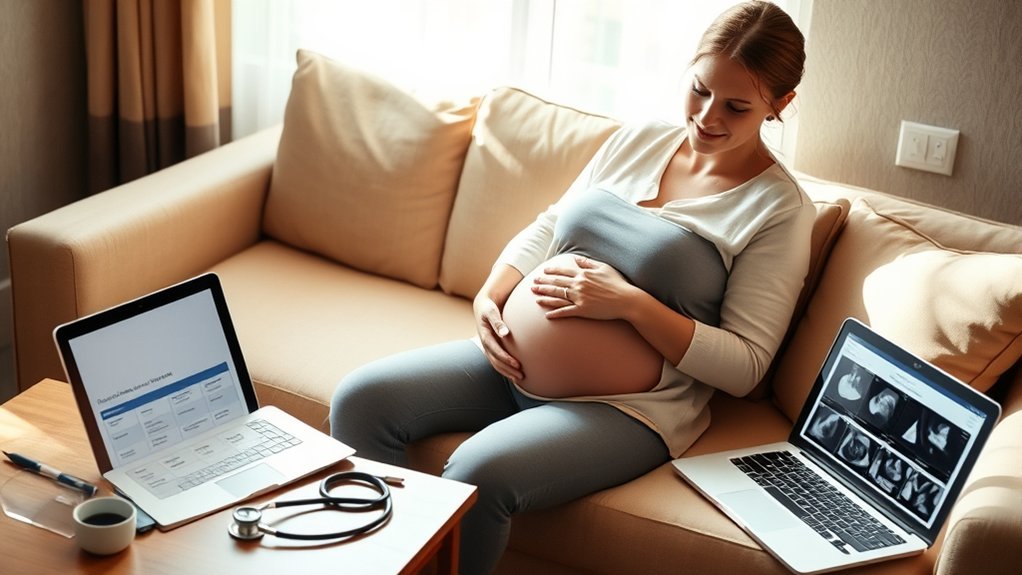Pregnancy with twins can feel like steering a double-edged sword, where excitement meets uncertainty. As you approach delivery, recognizing the signs and symptoms becomes essential for making informed decisions. From early signs of labor to the choice between vaginal birth and cesarean section, understanding these factors can shape your experience. Explore what to expect and how to prepare as you approach this significant moment in your journey.
Understanding Twin Pregnancy Symptoms
When you’re pregnant with twins, you might notice symptoms that differ from a singleton pregnancy. Increased hormone levels can lead to heightened morning sickness, fatigue, and emotional fluctuations. You may experience more pronounced physical changes, such as rapid weight gain and a larger belly size earlier in your pregnancy. Additionally, your body might show signs of discomfort sooner, with symptoms like pelvic pain and shortness of breath due to the additional pressure on your organs. It’s also common to experience increased fetal movement as both babies grow. Regular check-ups become essential, as monitoring for complications, such as gestational diabetes or preeclampsia, is vital in twin pregnancies. Understanding these symptoms helps you prepare for the unique challenges ahead.
Signs Indicating Delivery Approaches
As your due date approaches, recognizing the signs that indicate labor is imminent becomes essential, especially in a twin pregnancy. Being aware of these signs can help you prepare for delivery.
| Sign | Description |
|---|---|
| Lightening | Your belly drops as the babies engage in the pelvis. |
| Increased contractions | More frequent and intense contractions may occur. |
| Bloody show | A discharge that contains blood or mucus indicates cervical changes. |
| Water breaking | Amniotic fluid leaking suggests labor is near. |
| Nesting instinct | A sudden burst of energy to organize and prepare your home. |
Understanding these signs can help you determine when it’s time to head to the hospital and guarantee a smoother delivery experience.
Vaginal Birth vs. Cesarean Section for Twins
Choosing between vaginal birth and cesarean section for twins can greatly impact your delivery experience and recovery. Vaginal birth is often considered a safer option if both babies are positioned well, typically leading to shorter recovery times and less postoperative pain. However, it requires careful monitoring, as complications can arise quickly. A cesarean section may be necessary if there are concerns about the babies’ health or if one is in a breech position. While this method provides more control over the delivery process, it usually entails a longer recovery period and potential risks associated with surgery. Ultimately, understanding the pros and cons of each option will help you make an informed decision that aligns with your preferences and medical advice.
Factors Influencing Delivery Decisions
Several factors can considerably influence your delivery decisions when expecting twins. To begin with, the position of the babies plays an essential role; if both are head-down, vaginal delivery might be an option. Your health history, including any complications during pregnancy, also impacts the choice. Finally, your healthcare provider’s experience and recommendations are critical.
| Factor | Impact on Delivery Decision | Considerations |
|---|---|---|
| Baby Position | Influences delivery method | Head-down vs. breech |
| Maternal Health | Determines risks involved | Previous surgeries, conditions |
| Provider Expertise | Shapes delivery plan | Experience with twin deliveries |
Understanding these factors will help you make informed decisions about your delivery.
Preparing for a Twin Delivery
Preparing for a twin delivery involves careful planning and organization to guarantee a smooth process. Begin by discussing your birth plan with your healthcare provider, including your preferences for pain management and delivery method. It’s essential to understand the potential need for a cesarean section, as it’s sometimes necessary for twins. Arrange for help at home, as managing two newborns can be overwhelming. Double-check your hospital bag, ensuring you pack essentials for both babies. Consider attending prenatal classes specifically focused on multiple births for tailored information. Finally, establish a support network of family and friends, as their assistance will be invaluable postpartum. This preparation not only eases your anxiety but also sets the stage for a successful delivery experience.
Frequently Asked Questions
Can Twins Be Delivered Vaginally if One Is Breech?
Yes, twins can be delivered vaginally even if one is breech, but it depends on various factors like the position of the first twin and the mother’s health. Always consult your healthcare provider for personalized advice.
How Does Twin Delivery Affect Postpartum Recovery?
Delivering twins is like steering a double-edged sword; while it offers joy, postpartum recovery might be more challenging. You’ll face increased fatigue, emotional shifts, and potential complications, requiring extra support and care during this essential time.
Are There Additional Risks for Premature Twin Deliveries?
Yes, there are additional risks for premature twin deliveries, including respiratory issues, low birth weight, and developmental challenges. You should monitor for signs of complications and maintain close communication with your healthcare provider throughout the pregnancy.
How Can I Support My Partner During Twin Delivery?
During twin delivery, you can support your partner by staying calm, offering encouragement, and helping with breathing techniques. Research shows that emotional support can reduce stress and lead to better outcomes for both mother and babies.
What Are the Emotional Effects of Delivering Twins?
Delivering twins can evoke a mix of emotions, including joy, anxiety, and overwhelm. You might feel increased stress due to the complexities involved, but also immense pride and love when you hold your babies.
